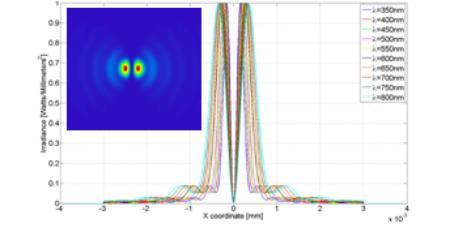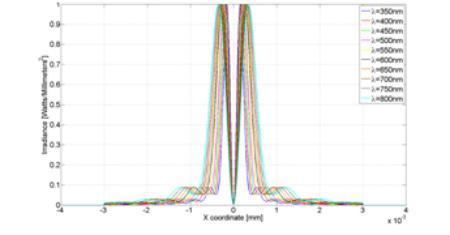Very High Resolution (µm scale) Optical Transition Radiation Beam Profile Monitor
Optical Transition Radiation (OTR) has become standard tools for beam imaging and emittance measurements, ever since it was first introduced in beam diagnostics applications in the late 70s by Wartski [1].
At the first commissioning stage of the future lepton collider CLIC, the beam intensity will be low enough to allow the use of OTR without destroying the OTR target due to high thermal load. OTR Beam Profile Monitor can be thus used for CLIC as single shot measurements for micrometer beam size measurements during the first stage of the commissioning where interceptive measurements are allowed.
At the Accelerator Test Facility 2 (ATF2, KEK, Japan), OTR Beam Profile Monitor has been implemented by the ATF2 collaborators of John Adams Institute and of Royal Holloway (with the help of the local ATF2 team) [2]. This monitor is located now at the beginning of the Final Focus System where it is possible to tune the beam in order to have vertical size down to one micrometer. The study is currently focused on the measurements of the Point Spread Function (PSF) [3], which represents the resolution of the instrument, and which is limited by chromatic and geometric aberrations as well as by diffraction [4].
The QUASAR group and the Beam Instrumentation (BI) group at CERN have been recently involved on the creation of a novel simulation tool in order to propose a new OTR system with better resolution. In fact, the existing analytical models can simulate the OTR source but the propagation is done only through thin lenses (thin lens approximation) and only diffraction is taken into account. In this novel simulation tool, the exact OTR source needs to be simulated and propagated through a designed optical line, including both aberrations and diffraction.
By using a commercial software called Zemax [5], a widely-used optical design program, in order to simulate the existing OTR system, and by simulating the OTR source for a single electron, as an input to Zemax, it is possible to study very realistically the PSF.
The equation of the OTR electric field at the source for vertical polarization component induced by a single electron [6] is written in a C source file, which is then compiled as a DLL and given to Zemax as input. Figure 1 shows the simulations of the OTR spatial distribution at the source for different wavelengths using this last equation.

Simulations of the OTR spatial distribution at the source for different wavelengths using the Physical Optics Propagation mode of Zemax
Zemax propagates this electric field through the designed optical line up to the image plane using the Physical Optics Propagation mode [7]. This mode uses diffraction calculations to propagate a wavefront through an optical system surface by surface and take into account all diffractions and aberrations occurring through the optical line. The methods used in Zemax are based upon the references [8] and [9]. The existing design of real commercial lenses in Zemax allows realistic simulations of aberrations occurring through these lenses.
These simulations have already reproduced the PSF measurements performed by the ATF2 collaborators (with the help of the local ATF2 team) with the current OTR system (see Figure below). These results are very encouraging for the validity of the source model and for the accuracy of diffraction and aberrations prediction.
The two lobes are well superimposed, even if measurements do not show tails as simulations do. In fact, simulations of the PSF were done for a single electron, while measurements were performed with an electron beam whose vertical size was focused to be close to the diffraction limited system, condition necessary to see the PSF. Destructive interferences may thus occur experimentally on the tails. Moreover, simulations were performed for a single wavelength, while the optical filters of the OTR system have a bandwidth of 40nm, which lead to achromatic aberrations. This last issue lead to a smoothing of the PSF. The next step will be thus to perform the convolution of the OTR distribution for a single electron by a Gaussian distribution of different sizes, and to perform the integration of the PSF within a bandwidth of 40nm.

Comparison of the PSF of the current OTR system at ATF2 between measurements (ϒ=2500) and simulations (ϒ=50) done with the Physical Optics Propagation mode of Zemax
Then, simulations have thus been performed in order to improve the current OTR system. They have already shown that the resolution of the current OTR system can be improved by a factor four by modifying the current design in different ways.
Some people of the BI group at CERN will go to ATF2 to perform PSF measurements with the new designed optical line in order to confirm the improved resolution and the performance of these simulations. This last point is very important since the simulation of the PSF has never been done in the past so accurately.
Currently involved QUASARs:
References:
[1] L. Wartski, Doctorate thesis, Université Paris-Sud, Orsay (1976)
[2] A. Aryshev et al., 'A novel method for sub-micrometer transverse electron beam size measurements using optical transition radiation', IOP Publishing, Journal of Physics: Conference Series 236 (2010) 012008
[3] M. Castellano and V. Verzilov, 'Spatial resolution in optical transition radiation beam diagnostics', Physical Review ST-AB 1 (1998) 062801
[4] P. Karataev et al., 'The first observation of the Point Spread Function of Optical Transition Radiation', Phys. Rev. Lett. 107, 174801 (2011)
[5] Zemax user’s manual, 15th October, 2012
[6] M. Castellano, A. Cianchi, G. Orlandi, V.A. Verzilov, 'Effects of diffraction and target finite size on coherent transition radiation spectra in bunch length measurements', Nuclear Instruments and Methods A 435 (1999) 297.
[7] A. Locke, 'Exploring Physical Optics Propagation in Zemax', Zemax Knowledge Base, 31th October 2005
[8] Goodman, Joseph W., 'Introduction to Fourier Optics', McGraw-Hill, New York (1968).
[9] Lawrence, George N. 'Optical Modeling', in Applied Optics and Optical Engineering, Volume 11, R. R. Shannon and J. C. Wyant, eds., Academic, New York (1992).
[10] E.Bravin, T. Lefevre, 'Studies of OTR angular distribution on CTF2', Proceedings DIPAC 2003, Mainz, Germany